#prince leopold queen victoria's son
Text
Ngl, you'd be into them. They got big noses.
@hogs-in-your-house




#christina of sweden#queen victoria#prince leopold queen victoria's son#cleopatra vii#another is that they have big eyes#queen victoria was considered beautiful when she was younger
2 notes
·
View notes
Text

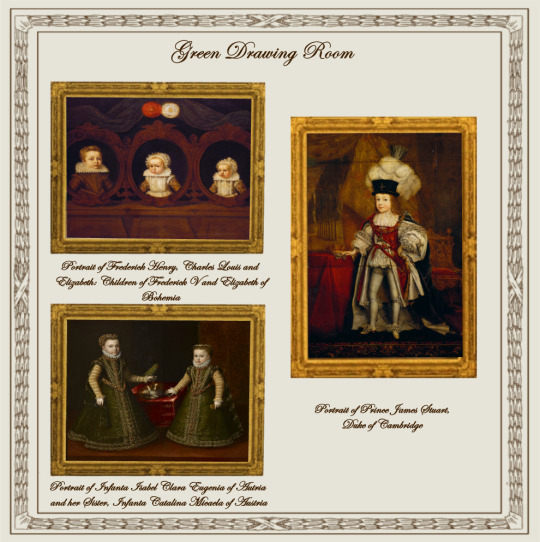
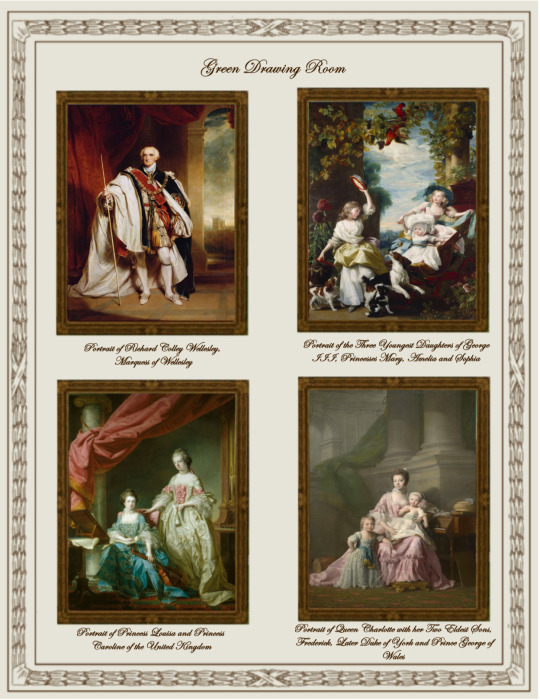
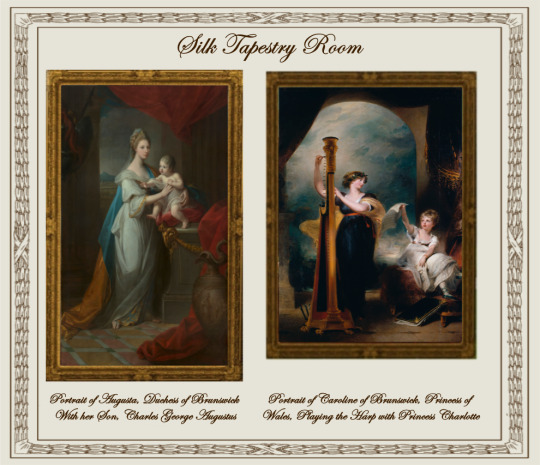
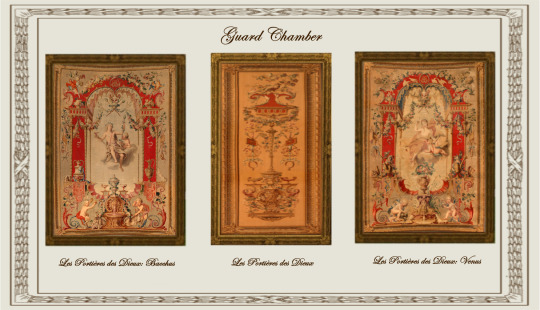

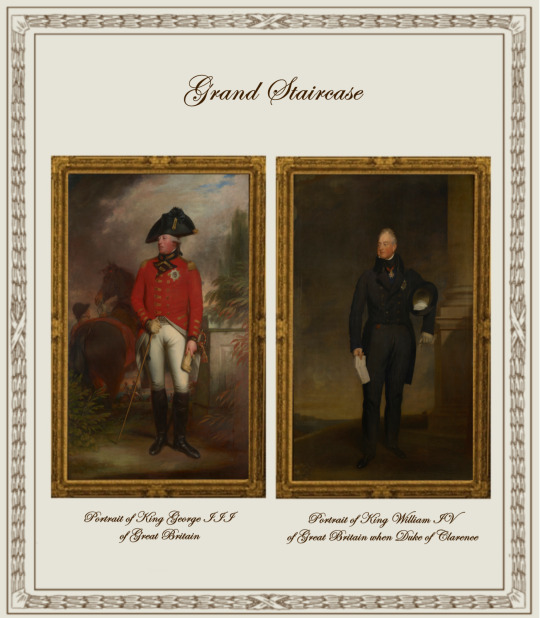
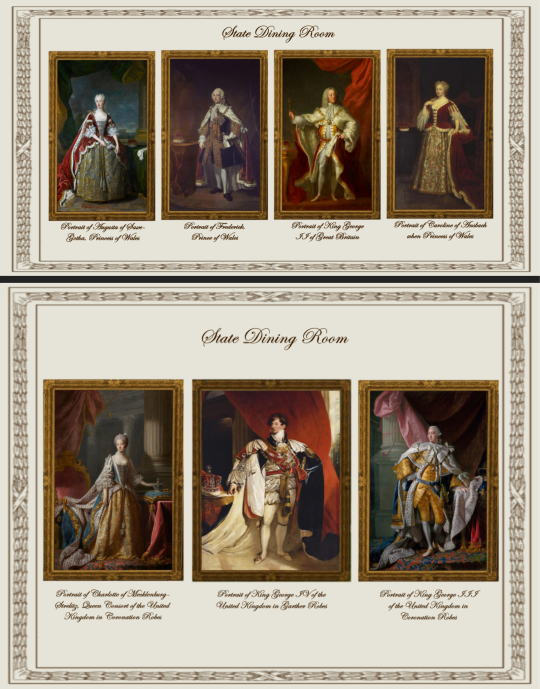
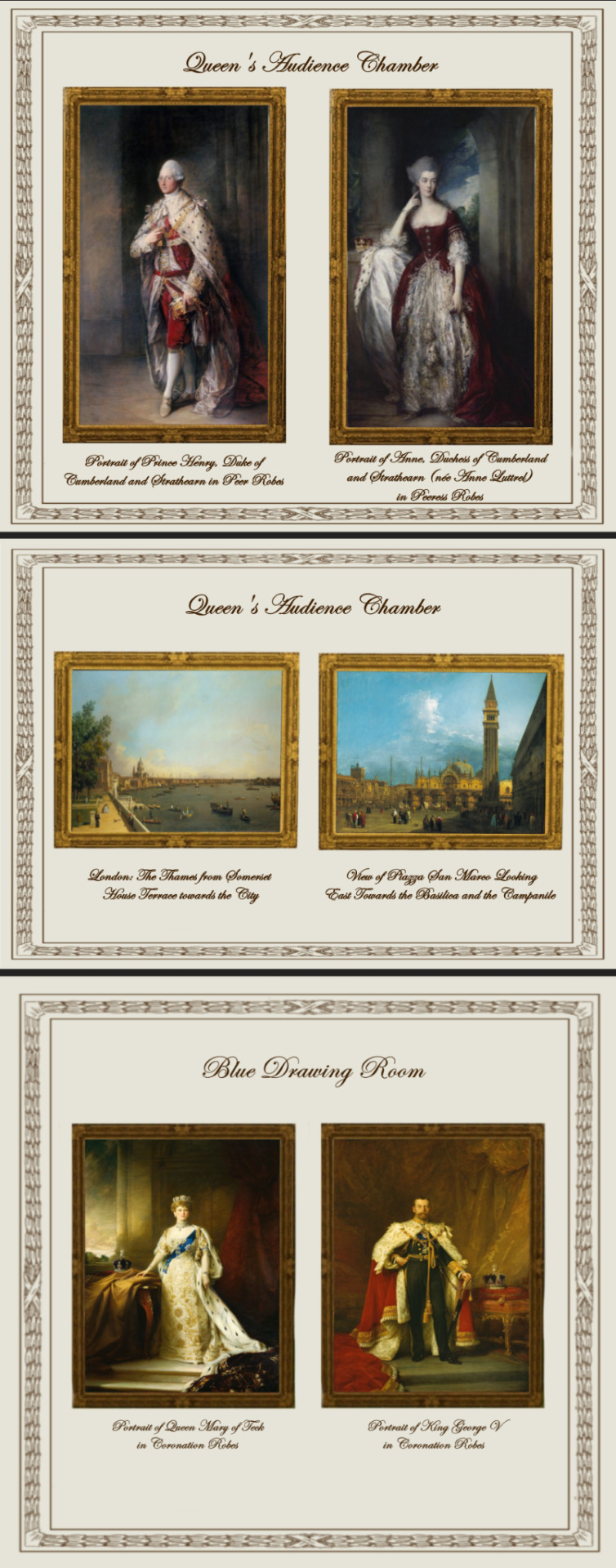
Paintings from Buckingham Palace: part I
A retexture by La Comtesse Zouboff — Original Mesh by @thejim07
100 followers gift!
First of all, I would like to thank you all for this amazing year! It's been a pleasure meeting you all and I'm beyond thankful for your support.
Spread among 13 occupied and historic royal residences in the United Kingdom, the collection is owned by King Charles III and overseen by the Royal Collection Trust. The British monarch owns some of the collection in right of the Crown and some as a private individual. It is made up of over one million objects, including 7,000 paintings, over 150,000 works on paper, this including 30,000 watercolours and drawings, and about 450,000 photographs, as well as around 700,000 works of art, including tapestries, furniture, ceramics, textiles, carriages, weapons, armour, jewellery, clocks, musical instruments, tableware, plants, manuscripts, books, and sculptures.
Some of the buildings which house the collection, such as Hampton Court Palace, are open to the public and not lived in by the Royal Family, whilst others, such as Windsor Castle, Kensington Palace and the most remarkable of them, Buckingham Palace are both residences and open to the public.
About 3,000 objects are on loan to museums throughout the world, and many others are lent on a temporary basis to exhibitions.
-------------------------------------------------------
This first part includes the paintings displayed in the White Drawing Room, the Green Drawing Room, the Silk Tapestry Room, the Guard Chamber, the Grand Staircase, the State Dining Room, the Queen's Audience Room and the Blue Drawing Room,
This set contains 37 paintings and tapestries with the original frame swatches, fully recolourable. They are:
White Drawing Room (WDR):
Portrait of François Salignan de la Mothe-Fénelon, Archbishop of Cambrai (Joseph Vivien)
Portrait of a Lady (Sir Peter Lely)
Portrait of a Man in Armour with a red scarf (Anthony van Dyck)
Portrait of Alexandra of Denmark, Queen Consort of the United Kingdom and Empress of India (François Flameng)
Green Drawing Room (GDR):
Portrait of Prince James Stuart, Duke of Cambridge (John Michael Wright)
Portrait of Frederick Henry, Charles Louis and Elizabeth: Children of Frederick V and Elizabeth of Bohemia (unknown)
Portrait of Infanta Isabel Clara Eugenia of Autria and her Sister, Infanta Catalina Micaela of Austria (Alonso Sanchez Coello)
Portrait of Princess Louisa and Princess Caroline of the United Kingdom (Francis Cotes)
Portrait of Queen Charlotte with her Two Eldest Sons, Frederick, Later Duke of York and Prince George of Wales (Allan Ramsay)
Portrait of Richard Colley Wellesley, Marquess of Wellesley (Martin Archer Shee)
Portrait of the Three Youngest Daughters of George III, Princesses Mary, Amelia and Sophia (John Singleton Copley)
Silk Tapestry Room (STR):
Portrait of Caroline of Brunswick, Princess of Wales, Playing the Harp with Princess Charlotte (Sir Thomas Lawrence)
Portrait of Augusta, Duchess of Brunswick With her Son, Charles George Augustus (Angelica Kauffmann)
Guard Chamber (GC):
Les Portières des Dieux: Bacchus (Manufacture Royale des Gobelins)
Les Portières des Dieux: Venus (Manufacture Royale des Gobelins)
Les Portières des Dieux (Manufacture Royale des Gobelins)
Grand Staircarse (GS):
Portrait of Adelaide of Saxe-Meiningen, Queen Consort of Great Britain (Martin Archer Shee)
Portrait of Augustus, Duke of Sussex (Sir David Wilkie)
Portrait of Edward, Duke of Kent (George Dawe)
Portrait of King George III of Great Britain (Sir William Beechey)
Portrait of King William IV of Great Britain when Duke of Clarence (Sir Thomas Lawrence)
Portrait of Leopold I, King of the Belgians (William Corden the Younger)
Portrait of Prince George of Cumberland, Later King George V of Hanover When a Boy (Sir Thomas Lawrence)
Portrait of Princess Charlotte Augusta of Wales (George Dawe)
Portrait of Queen Charlotte at Frogmore House (Sir William Beechey)
Portrait of Victoria of Saxe-Coburg-Saafeld, Duchess of Kent (Sir George Hayter)
State Dining Room (SDR):
Portrait of Charlotte of Mecklenburg-Strelitz, Queen Consort of the United Kingdom in Coronation Robes (Allan Ramsay)
Portrait of King George III of the United Kingdom in Coronation Robes (Allan Ramsay)
Portrait of Augusta of Saxe-Gotha, Princess of Wales (Jean-Baptiste Van Loo)
Portrait of Caroline of Ansbach when Princess of Wales (Sir Godfrey Kneller)
Portrait of Frederick, Princes of Wales (Jean-Baptiste Van Loo)
Portrait of King George II of Great Britain (John Shackleton)
Portrait of King George IV of the United Kingdom in Garther Robes (Sir Thomas Lawrence)
Queen's Audience Room (QAR):
Portrait of Anne, Duchess of Cumberland and Strathearn (née Anne Luttrel) in Peeress Robes (Sir Thomas Gainsborough)
Portrait of Prince Henry, Duke of Cumberland and Strathearn in Peer Robes (Sir Thomas Gainsborough)
London: The Thames from Somerset House Terrace towards the City (Giovanni Antonio Canal "Canaletto")
View of Piazza San Marco Looking East Towards the Basilica and the Campanile (Giovanni Antonio Canal "Canaletto")
Blue Drawing Room (BDR)
Portrait of King George V in Coronation Robes (Sir Samuel Luke Fildes)
Portrait of Queen Mary of Teck in Coronation Robes (Sir William Samuel Henry Llewellyn)
-------------------------------------------------------
Found under decor > paintings for:
500§ (WDR: 1,2 & 3)
1850§ (GDR: 1)
1960§ (GDR: 2 & 3 |QAR 3 & 4)
3040§ (STR, 1 |GC: 1 & 2|SDR: 1 & 2)
3050§ (GC:1 |GS: all 10|WDR: 4 |SDR: 3,4,5 & 6)
3560§ (QAR: 1 & 2|STR: 2)
3900§ (SDR: 7| BDR: 1 & 2|GDR: 4,5,6 & 7)
Retextured from:
"Saint Mary Magdalene" (WDR: 1,2 & 3) found here .
"The virgin of the Rosary" (GDR: 1) found here .
"The Four Cardinal Virtues" (GDR: 2&3|QAR 3 & 4) found here.
"Mariana of Austria in Prayer" (STR, 1, GC: 1 & 2|SDR: 1 & 2) found here.
"Portrait of Philip IV with a lion at his feet" (GC:1 |GS: all 10|WDR: 4 |SDR: 3,4,5 & 6) found here
"Length Portrait of Mrs.D" (QAR: 1 & 2|STR: 2) found here
"Portrait of Maria Theresa of Austria and her Son, le Grand Dauphin" (SDR: 7| BDR: 1 & 2|GDR: 4,5,6 & 7) found here
(you can just search for "Buckingham Palace" using the catalog search mod to find the entire set much easier!)
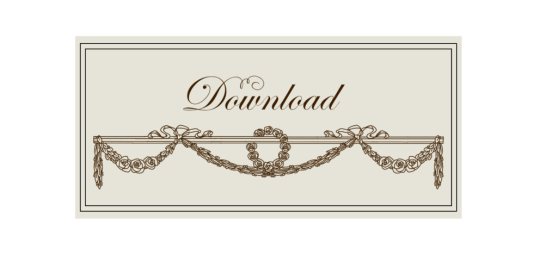
Drive
(Sims3pack | Package)
(Useful tags below)
@joojconverts @ts3history @ts3historicalccfinds @deniisu-sims @katsujiiccfinds @gifappels-stuff
-------------------------------------------------------
#the sims 3#ts3#s3cc#sims 3#sims 3 cc#sims 3 download#sims 3 decor#edwardian#rococo#baroque#renaissance#buckingham#buckingham palace#royal collection trust#wall decor
95 notes
·
View notes
Text
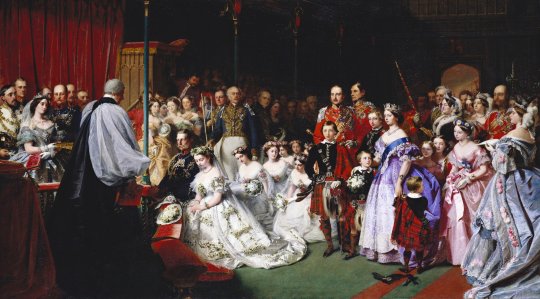

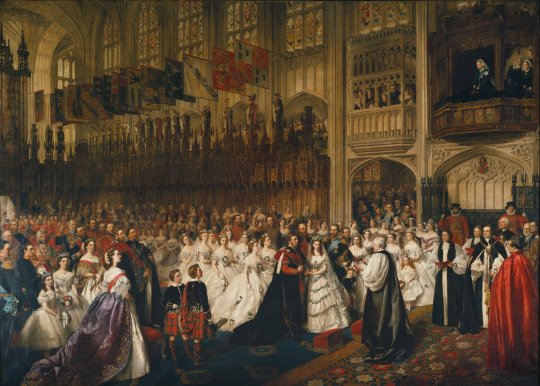



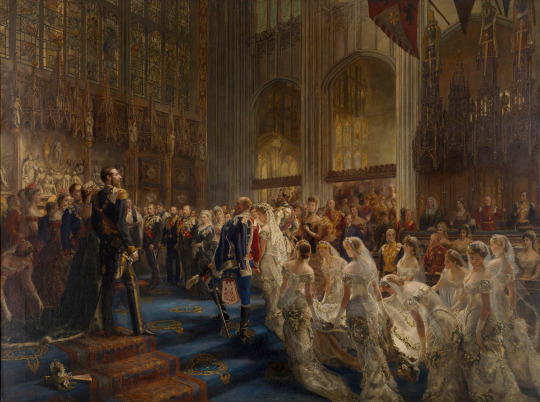
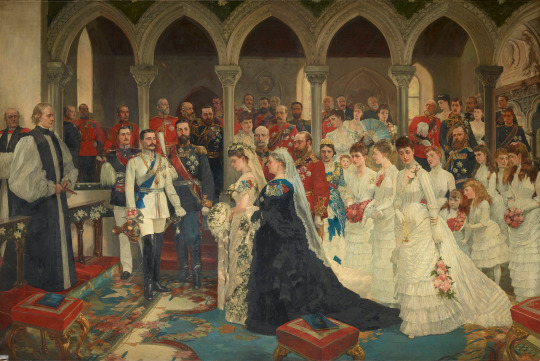

Wedding Portraits of Queen Victoria and Prince Albert’s children (9 of 10) and their respective spouses, 1858 - 1885.
Victoria, Princess Royal (eldest daughter) married Prince Frederick William of Prussia (later German Emperor Frederick III and Empress Victoria) on January 25, 1858. Portrait by John Phillip.
Princess Alice (second daughter) married Louis IV, Grand Duke of Hesse and by the Rhine on July 1, 1862. Portrait by William Powell Frith.
Albert Edward, Prince of Wales married Princess Alexandra of Denmark (later King Edward VII and Queen Alexandra) on March 10, 1863. Portrait by Franz Xaver Winterhalter.
Princess Helena (third daughter) married Prince Christian of Schleswig-Holstein on July 5, 1866. Portrait by Christian Karl Magnussen.
Princess Louise (fourth daughter) married John Campbell, 9th Duke of Argyll on March 21, 1871. Portrait by Sydney Prior Hall.
Prince Alfred, Duke of Edinburgh and of Saxe-Coburg and Gotha married Grand Duchess Maria Alexandrovna of Russia on January 23, 1874. Portrait by Nicholas Chevalier.
Prince Arthur, Duke of Connaught and Strathearn (third son) married Princess Louise Margaret of Prussia on March 13, 1879. Portrait by Sydney Prior Hall.
Prince Leopold, Duke of Albany (fourth son) married Princess Helena of Waldeck and Pyrmont on April 27, 1882. Portrait by Sir James Dromgole Linton.
Princess Beatrice (youngest daughter) married Prince Henry of Battenberg on July 23, 1885. Portrait by Richard Catton Woodville.
#british royal family#ktd#brf#queen victoria#art#art history#prince albert#hopefully#i got them all right lol
36 notes
·
View notes
Photo

The room in the Villa Nevada, Cannes, containing the coffin of Prince Leopold, The Duke of Albany, son of Queen Victoria
117 notes
·
View notes
Text
Watching Queen Charlotte: A Bridgerton Story Episode 1:
I love both young and older Queen Charlotte. The actresses are very convincing at playing the same character at different points in their life.
Charlotte comes off as a brat at first, but after her brother explains why he could not refuse the betrothal, she becomes a lot better.
I like how she wanted what her husband was like and how she become frustrated when the servants only told her that he was the king.
Young Lady Danbury is perfect in her later scenes, but I hate her introduction. Showing a dark-skinned, young black woman having miserable sex with her geriatric dark-skinned husband is not a good look for Netflix.
I wonder if Prince Augusta's line about Charlotte's skin color was inspired by that line from the Sussexs' Oprah interview.
The inclusion of the wealthy non-white families to George and Charlotte's wedding came across as a rushed job. I would have liked it better if they had invited to the wedding from the beginning. I am also confused that George is not informed about this given that he is the king.
George and Charlotte's first meeting was so cute. The actors have great chemistry.
The wedding and ball scene was beautiful, but I wished that Lady Danbury had danced with Charlotte's brother, Adolphus. She deserves something nice for dealing with her much older husband.
I have mixed feelings about the last scene between George and Charlotte. It does not make sense given how romantic George was to Charlotte in their earlier scenes.
My current theory is that George wants Charlotte to live separate from him because of his mental health problems, and he does not want to expose her to them.
Older Queen Charlotte's scene with her adult children is so funny and mostly historically accurate.
The real-life King George IV and Queen Charlotte did not have any legitimate grandchildren after Princess Charlotte of Wales died. Their adult sons other than Prince Regent George were practically forced to make proper martial matches after their only legitimate niece died in childbirth.
Fun fact. Princess Charlotte's widower was the future King Leopold I of Belgium and one of Queen Victoria's maternal uncles.
I wonder if the mention of Queen Charlotte's many illegitimate grandchildren is a possible set-up for the show's version of Sophie Beckett.
#queen charlotte: a bridgerton story#young queen charlotte#young king george#young lady danbury#watching episode 1 of the bridgerton Queen Charlotte spinoff#Young Lady Danbury deserves so much better#George x Charlotte (Bridgerton)
63 notes
·
View notes
Text

Queen Victoria adored and admired her husband Prince Albert, She tried to bring up her children in such a way that they have the same morals and behavior as Prince Albert.
Among all her children, her the seventh child and third son, Prince Arthur, had a very similar behavior towards his father, Prince Albert, and that was enough for him to become the favorite of his mother, Queen Victoria.🥺💙
Some of the writings and letters in which Queen Victoria mentioned Arthur's name:
Queen Victoria wrote about Prince arthur to her husband Prince Albert:
“This child is dear, dearer than any of the others put together, thus after you he is the dearest and most precious object to me on Earth.”
“Little Arthur is really very handsome & I may truly say a most darling & promising Child.”
- Queen Victoria to Leopold I, 28th June 1853
“Arthur sat with me & I gave him a locked with my hair. he came up to my room to take leave & with many tears & kissed I ported from my precious Boy, who has never caused me a moment; sorrow. May God bless & bring him back to us safely! I saw him off at the door & going up alone, thought of many sad leave takings, when dearest Albert had been with me. Thinking so much of dear Arthur.”
- Queen Victoria’s diary, 12th August 1869
“Dear Arthur left us on Thursday and it was a very sad parting, as we are all so fond of him. He is so beloved in the house and by everyone - for he is so good and unassuming, always cheerful and never makes mischief. We shall miss him much.”
- Queen Victoria to the Crown Princess of Prussia, 14th August 1869
27 notes
·
View notes
Text
Wisteria Lodge
Our third story from His Last Bow - we've already done "The Dying Detective" and "The Cardboard Box".
This was published in two parts in The Strand.
Take a note of the Watsonian date here because this will be important later.
A reply-paid telegram was one where the sender also paid for the cost of any reply, up to a certain word limit (48 words for inland telegrams in the 1896 Post Office Guide).
You could send a telegram at most bigger post offices, or you could complete a pre-paid form and put it in a post box.
"Toilet" had a definition of the style of one's appearance.
Eccles is from Lee, which we've visited already in "The Man with The Twisted Lip" and which I discuss in my post for that.
Esher is today a town of around 7,000 people but part of a larger built-up area, thirteen miles from Charing Cross. While sitting outside the Greater London boundary in Surrey, the urban sprawl of London does not match the administrative boundaries and Esher is on the outer edge of this. You can in fact hit some serious countryside while staying within the city limits.
It also sat outside the Metropolitan Police District.
The town was historically a stagecoach stop on the London to Portsmouth road, which later become the A3 before that was diverted via a bypass around the town. It is home to the Sandown Park racecourse and George Harrison lived there for a while.
The railway station, then called Esher and Claremont (the latter being a Lancelot "Capability" Brown-designed mansion, then owned by a widowed daughter-in-law of Queen Victoria, her youngest son Prince Leopold having died due to haemophilia after a fall in 1884) is on the mainline from Waterloo to Weymouth - Aldershot being a bit further along on a branch line. It takes around half an hour to get there by modern electric train; only suburban services stop there, with express trains going straight through the disused centre platforms.
Spain, as a major power (even if most of its empire had already gone) and a monarchy, warranted an Embassy. San Pedro only would have had a legation.
There's quite a bit of racism in this one!
Some pictures of dog-grates can be found here.
Doors on many trains could be opened from the inside at the time, including on the move with the associated risks involved.
War crimes trials were not really a thing at this time.
Yet another case of the villains dying off-page!
The broad plot of this would not be out of place in a modern crime drama.
21 notes
·
View notes
Note
Which prospect do you think Has a higher chance with alexei ? Princess Ileana of Romania or Princess Elizabeth of Greece and Denmark?
Hi! Thanks for the question and I'm so sorry for the very late reply!
This is a difficult one to answer as it's all guesswork.
In terms of wider family relations, it appears that no one really liked Carol (I don't blame them!!) when they visited in 1913, and Queen Marie of Romania wasn't particularly enthusiastic about Alix in her memoirs. She also explicitly said that she did NOT want to have someone with haemophilia in her family due to the suffering it brings. She mentioned being concerned about Carol marrying one of OTMA because of the possibility they could be a carrier of the haemophilia gene. I don’t know if she knew that Alexei had haemophilia when she knew the Romanov family, but I think she might have avoided the match if she was aware. Although any of Alexei's children wouldn't have had haemophilia (only passes through the female line), the chance of him passing from a fatal attack at any moment certainly wouldn't be ideal for a marriage match.


Elizabeth and Alexei were very close in age, and there are some very sweet anecdotes about them meeting when they were children. Elizabeth's mother was Russian, which might have made the match more favourable. Also, they seemed to know each other far better than Alexei did Ileana, as Elizabeth and her family visited Russia pretty much yearly. Because of Marie of Romania's fears about haemophilia, and her dislike (and pitying) of Alix, I think that the match with Elizabeth would have been more favourable.
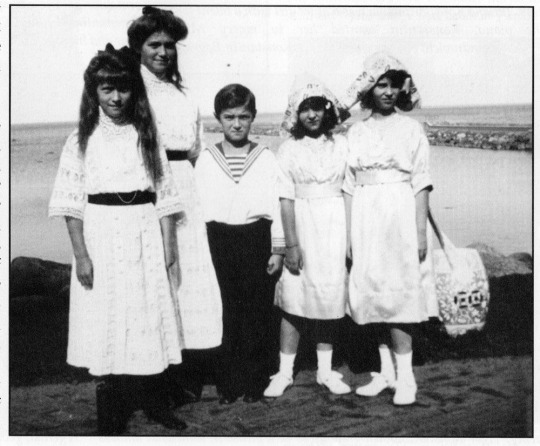
Which also brings up the fact that many boys that suffered from haemophilia sadly didn't live long into adulthood. Alix's brother Frittie passed away after an accident where he fell out of a window, and Henry of Prussia (Alix's nephew) passed away after falling off a chair. Tragically, most children died before they reached their teenage years. Some people with haemophilia lived considerably longer, though. Prince Waldemar of Prussia (a cousin) lived to age 59, until he passed away due to a lack of medical supplies for a blood transfusion. Alfonso of Spain died when he was 31 after a minor car crash caused internal bleeding, and his brother Gonzalo also passed away after a minor car accident, aged only 19. Most famously, Prince Leopold, son of Queen Victoria, died from a fall that resulted in cerebral haemorrhage.
We will never know for certain, I'm afraid, but those are my thoughts! What does anyone else think?
#q#ask#answered#anon#Alexei Nikolaevich#Marie of Romania#Ileana of Romania#Elizabeth of Greece#cousins
20 notes
·
View notes
Note
Sofia looks SO much like her 1st cousin 5 times removed, Prince Charles Edward Duke of Saxe Coburg and Gotha, and his daughter Sybilla (current mother of King Carl XVI Gustafson of Sweden!)
Hi! May I ask how are they related??
Yes of course!
So Sofia’s grandmother is Queen Sofia of Spain aka Princess Sofia of Greece (before marriage), her mother was of German blood and her name was Princess Frederica, Sofia’s Great-Grandmother. Frederica’ mother was named Princess Victoria-Louise of Prussia and was Sofia’s Great-Great-Grandmother. Victoria-Louise’s father was Kaiser Wilhelm II, Sofia’s Great-Great-Great-Grandfather.
Wilhelm’s 1st cousin (for example: Prince William and Princess Beatrice of the UK) was Prince Charles Edward of Saxe Coburg and Gotha through his mother’s (German Empress Victoria aka Victoria Princess Royal) brother Prince Leopold Duke of Albany (whose son was Charles Edward. Because Charles Edward and Wilhelm were 1st cousins, that makes Victoria Louise and Sybilla (Charles Edward’s daughter) 2nd cousins since their parents were first cousins. Charles Edward was therefore 5 times removed from Sofia, and Sybilla was 4 times removed.
Here is a quick family tree (not my best work but I tried lol)

I hope this helps and thank you for asking!
11 notes
·
View notes
Text

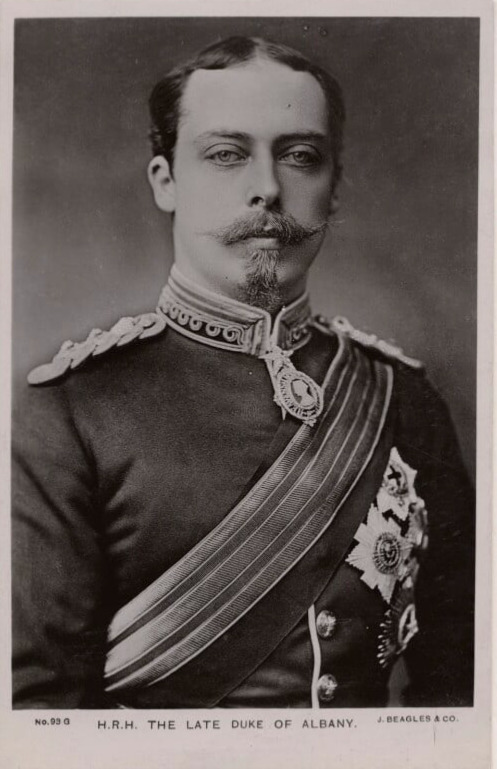
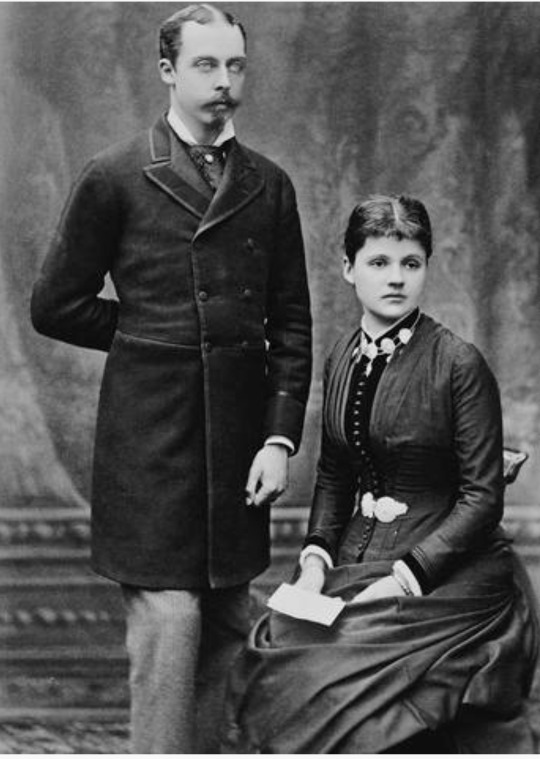
Prince Leopold, Duke of Albany (1853 - 1884)
I recently read a book (Queen Victoria's Youngest Son: The Untold Story of Prince Leopold, by Charlotte Zeepvat) about this remarkable young man and have wanted to pay some sort of homage to him, as he had a difficult, short life but accomplished much during it.
This cousin of the Romanovs, the eighth child and youngest son of Queen Victoria and her consort Prince Albert was born with hemophilia and might have also had epilepsy. During his childhood, he was under the constant supervision of staff and physicians, and his activity was severely restricted. He had numerous hemorrhagic crises.
Leopold was an extremely bright individual. Prince Albert and his early teachers noticed his intellectual gifts when he was very young. Leopold attended Oxford University. He was eventually made a privy council member and became a patron of the arts and literature. He also served as the unofficial secretary to his mother. Although he could not pursue active military service, he had an honorary association with various regiments. He was a Freemason.
His illness was first described in medical journals in 1868 and subsequently in the London and provincial newspapers. Since they could not conceal all information about Leopold's illness, the royal family carefully managed news about his health (as they did about all royalties); many newspapers reported widespread public sympathy for the queen's illnesses and her children's illnesses.
At the time, physicians recommended that hemophiliacs spend as much time as possible in warm climates, a suggestion that Leopold followed as much as possible throughout his life. The fact that this royal young man had the illness spiked much research on hemophilia at the time. Although the information aided comprehension by the general public, overall, however, very little could be done to save hemophiliacs from painful experiences and early deaths.
Prince Leopold married Princess Helen of Waldeck and Piedmont, and they had two children, a daughter and a son. His son was born after Leopold's death. Prince Leopold died at the age of 30, after a fall, apparently from a cerebral hemorrhage.
Trivia: Through his son, Prince Leopold is the great-grandfather of Carl XVI Gustaf, the current King of Sweden (I took a good look at Gustaf while writing this and I see a resemblance.)
10 notes
·
View notes
Text
Introducing The Royal Family of Nevodia
The Royal Family currently comprises of The King and Queen, their three children, their three children-in-law, and their seven grandchildren.

His Majesty King Edward with his wife Her Majesty Queen Victoria.
King Edward has had a long and successful reign as monarch, raising his children to be the future of the monarchy. He married Lady Victoria Williams shortly after ascending as King and they have had many happy years together.

The Children of The King and Queen of Nevodia. (L-R) HRH The Princess Lilah, The Duchess of Pendula, HRH The Crown Princess Adelaide, The Duchess of Willow Creek, HRH The Prince Arthur, The Duke of Magnolia.

The Crown Princess Family, Her Royal Highness The Crown Princess Adelaide, The Duchess of Willow Creek, her husband His Royal Highness Adam, Duke Consort of Willow Creek, and their children Their Royal Highnesses Prince William, Prince Thomas and Princess Eliana of Willow Creek.
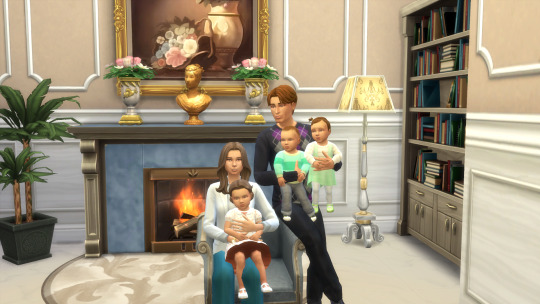
The Magnolia Family; His Royal Highness The Prince Arthur, The Duke of Magnolia, his wife Her Royal Highness Arabella, The Duchess Consort of Magnolia, and their children Their Highnesses Princess Sophia, Princess Evangeline and Prince Adrian of Magnolia.
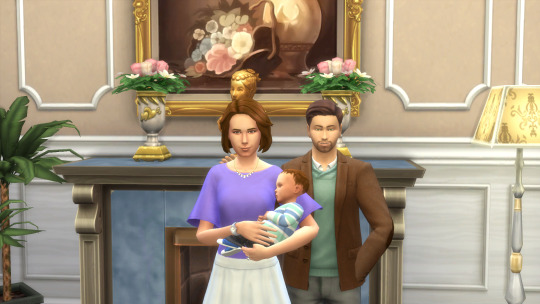
The Pendula Family; Her Royal Highness The Princess Lilah, The Duchess of Pendula, her husband His Royal Highness Jack, Duke Consort of Pendula, and their son His Highness Prince Leopold (“Leo”) of Pendula.
#sims 4#sims royalty#sims royal family#Monarchy of Nevodia#Royal Family of Nevodia#Sim: Edward George Blount#Sim: Victoria Williams#Sim: Adelaide Louise Blount#Sim: Arthur Henry Blount#Sim: Lilah Alexandra Blount#Sim: Adam Alford#Sim: Arabella Bounchard#Sim: Jack Lawton#Sim: William Adam Alford-Blount#Sim: Thomas George Alford-Blount#Sim: Eliana Victoria Alford-Blount#Sim: Sophia Marie Blount#Sim: Evangeline Georgina Blount#Sim: Adrian Edward Blount#Sim: Leopold Edmund Lawton
3 notes
·
View notes
Text
The people with hooked noses really made them got famous lovers eh?

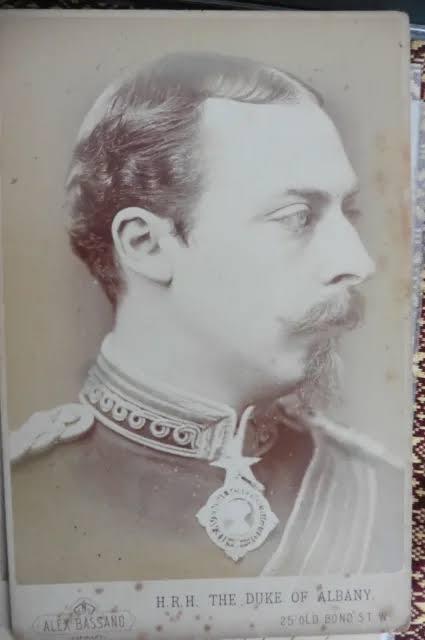
#prince leopold#prince leopold duke of albany#queen victoria's son#cleopatra vii#this is a coincidence#but apparently people like hooked noses
1 note
·
View note
Text
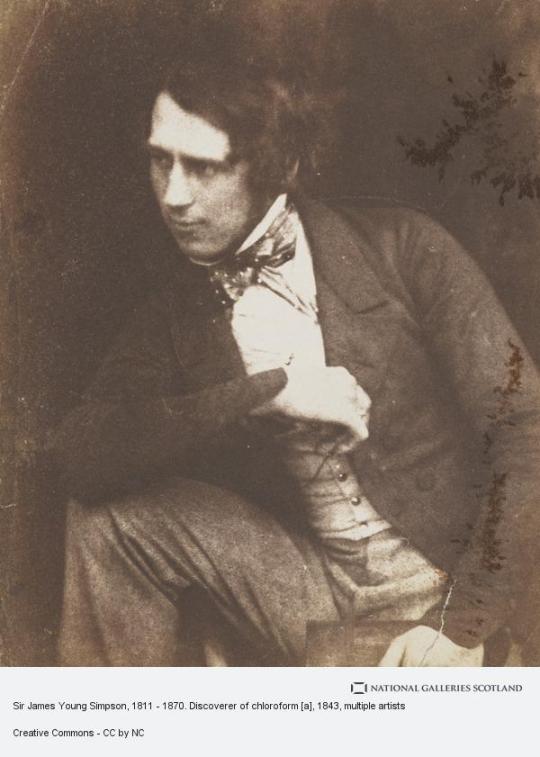


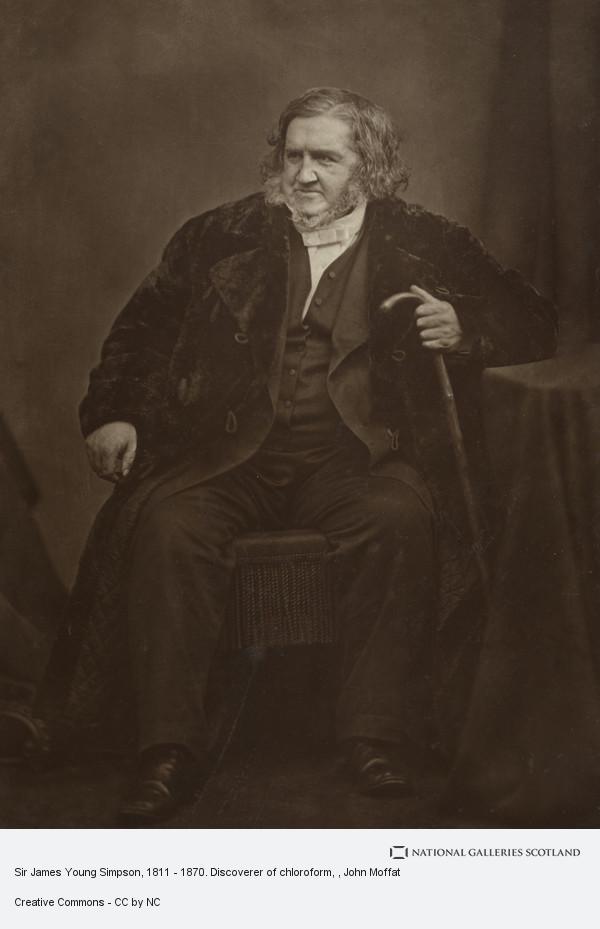
On May 6th 1870 Sir James Simpson, Scottish physician, died.
Born in Bathgate, the son of a baker. Simpson attended the University of Edinburgh from the age of only 14, graduating in 1832. He was appointed to a Chair of Midwifery at the same institution in 1840, quickly establishing the position of this subject as a popular and essential part of medical education. He was a pioneer in the use of anaesthetics, particularly chloroform, developing its use in surgery and midwifery. He introduced ether to obstetric practice in 1847, but in a search for something better, Simpson tried different anaesthetic agents with his colleagues by inhaling their vapours around the dinner table at his home.
He championed the use of chloroform against medical, moral and religious opposition. It was not until Queen Victoria used this anaesthetic during the birth of Prince Leopold that its use became generally accepted. Simpson also pioneered obstetric techniques and responsible for much reform of hospital practice while working at the Infirmary in Edinburgh. In 1866 Simpson became the first person to be knighted for services to medicine.
Simpson is buried in Warriston Cemetery in Edinburgh. Around 1700 medical colleagues and public figures joined his funeral procession and more than 100,000 people lined the route to the cemetery.
He is remembered by the Simpson Memorial Maternity Pavilion in Edinburgh, the most westerly of Princes Street Gardens statue is of the man himself.
7 notes
·
View notes
Text
Royal Wedding on 10 February 1904 at St George's Chapel, Windsor Castle.
Prince Alexander of Teck (29) and Princess Alice of Albany (20).
The bride was the eldest born child of Queen Victoria's youngest son the late Prince Leopold, Duke of Albany by his German wife Princess Helena of Waldeck and Pyrmont.
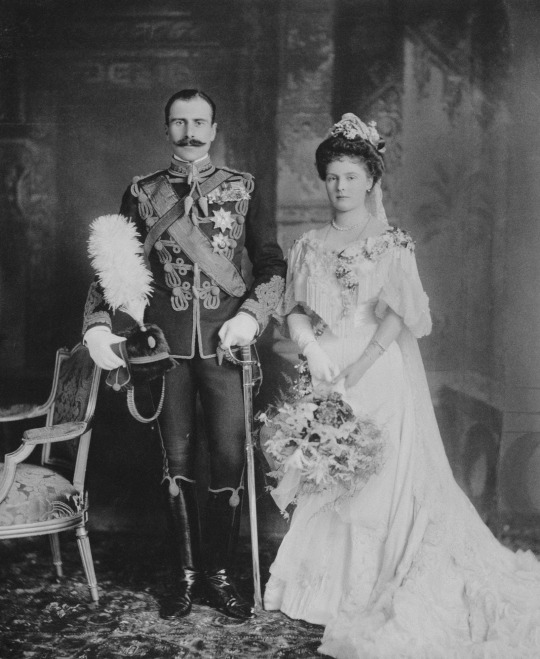

The bridegroom was the youngest son of Francis, Duke of Teck by his wife Princess Mary Adelaide of Cambridge. His elder sister was the wife of Princess Alice's first cousin King George V.
The beautiful bride in her wedding dress


Their bridesmaids

The bride and bridegroom with the bridesmaids.

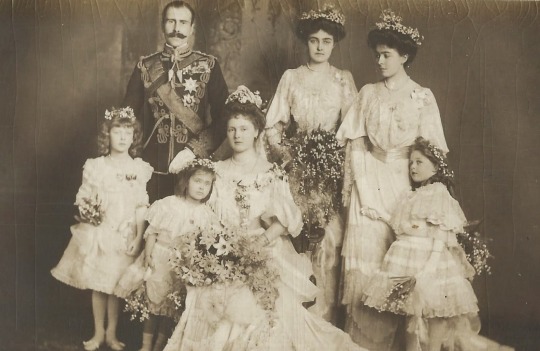

#princess alice of albany#prince alexander of teck#princess margaret of connaught#princess patricia of connaught#mary princess royal#princess helena of waldeck and pyrmont#princess mary of teck#1904#1900s#british royal wedding#british royal family#british royal fandom
44 notes
·
View notes
Text
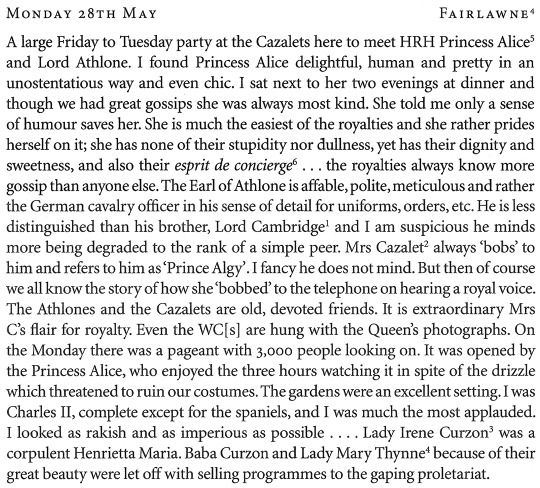
Henry ‘Chips’ Channon: The Diaries (Vol. 1), 1918-38, entry for 28th May 1923
—
Monday 28th May — Fairlawne¹
A large Friday to Tuesday party at the Cazalets here to meet HRH Princess Alice² and Lord Athlone. I found Princess Alice delightful, human and pretty in an unostentatious way and even chic. I sat next to her two evenings at dinner and though we had great gossips she was always most kind. She told me only a sense of humour saves her. She is much the easiest of royalties and she rather prides herself on it; she has none of the stupidity nor dullness, yet has their dignity sweetness, and also their esprit de concierge³ . . . the royalties always know more gossip than anyone else. The Earl of Athlone is affable, polite, meticulous and rather and the German cavalry officer in his sense of detail for uniforms, orders, etc. He is less distinguished than his brother, Lord Cambridge⁴ and I am suspicious he minds more being degraded to the rank of a simple per. Mrs Cazalet⁵ always ‘bobs’ to him and refers to him as ‘Prince Algy’. I fancy he does not mind. But then of course we all know the story of how she ‘bobbed’ to the telephone on hearing a royal voice. The Athlones and the Cazalets are old, devoted friends. It is extraordinary Mrs C’s flair for royalty. Even the WC[s] are hung with the Queen’s photographs. On the Monday there was a pageant with 3,000 people looking on. It was opened by the Princess Alice, who enjoyed the three hours watching it in spite of the drizzle which threatened to ruin our costumes. The gardens were an excellent setting. I was Charles II, complete except for the spaniels, and I was much the most applauded. I looked as rakish and as imperious as possible . . . . Lady Irene Curzon⁶ was a corpulent Henrietta Maria. Baba Curzon and Lady Mary Thynne⁷ because of their great beauty were let off with selling programmes to the gaping proletariat.
—
1. An estate in west Kent, near Tonbridge, owned by the Cazalet family from 1880.
2. Princess Alice Mary Victoria Augusta Pauline (1883-1981), daughter of Prince Leopold, Duke of Albany, youngest son of Queen Victoria; she was therefore the King’s cousin. She married in 1904 Prince Alexander of Teck (1874-1957), brother of the future Queen Mary; his title was anglicised in 1917 after the creation of the House of Windsor and he was granted the earldom of Athlone, after which his wife was known as Princess Alice, Countess of Athlone.
3. The spirit of a concierge; collecting gossip about all who pass through.
4. Adolphus Charles Alexander Albert Edward George Philip Louis Ladislaus, Duke of Teck (1868-1927). Like his brother, he relinquished his German titles in 1917 and, as brother of the Queen Consort, was created 1st Marquess of Cambridge. His younger brother was one rank below him in the peerage.
5. Maud Lucia Heron-Maxwell (1868-1952), married in 1893 William Marshall Cazalet (1865-1932); she was the mother of Victor Cazalet.
6. Mary Irene Curzon (1896-1966), known as Lady Irene Curzon after her father’s advancement to an earldom in 1911, was Lord Curzon’s eldest daughter. On his death in 1925 she inherited the barony of Ravensdale, and in 1958 was enabled to sit in the House of Lords by being granted a life peerage. She never married, declining a proposal from Victor Cazalet.
7. Lady Mary Beatrice Thynne (1903-74), third daughter of the 5th Marquess of Bath; she married in 1927 Charles Wilson (1904-74), 3rd Baron Nunburnholme.
#chips channon#channon diaries#1923#1920s#william cazalet#maud cazalet#alice athlone#alexander athlone#adolphus cambridge#irene ravensdale#baba metcalfe#mary nunburnholme#🕰️
4 notes
·
View notes
Photo
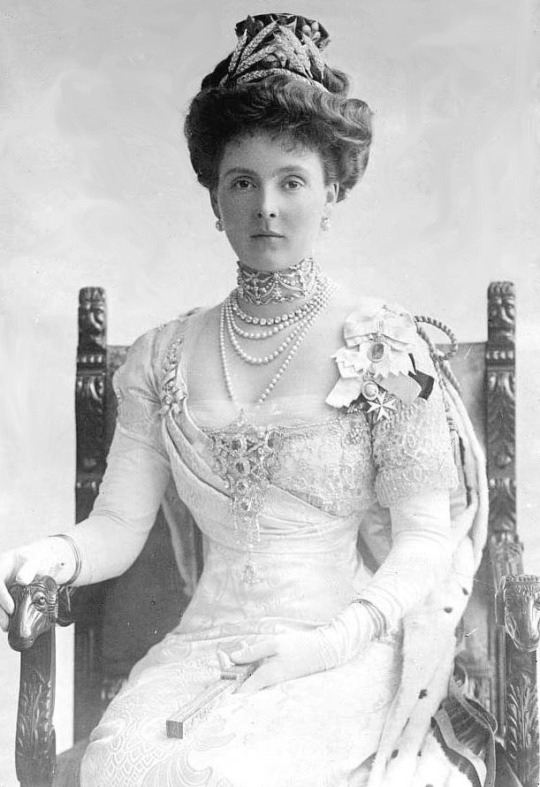
Princess Alice of Teck, daughter of Queen Victoria’s youngest son, Prince Leopold, at the Coronation of Edward V11 in 1911. You can just make out the velvet material of her coronet behind her jewelled head piece.
Credit, Great Ladies
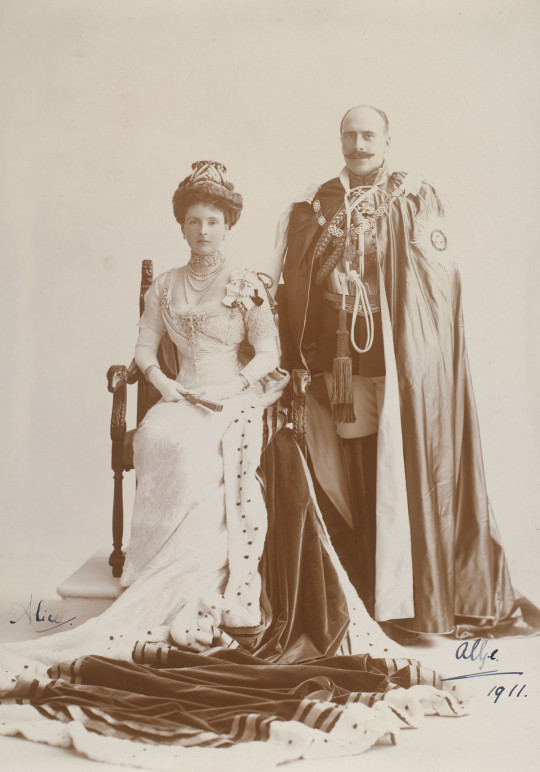
Princess Alice of Teck at the Coronation of Edward VII, with her husband the Earl of Athlone (later Governor General of Canada). The Earl is wearing the robes of the Order of the Bath.
Picture, Royal Collection Trust
Thank you❤️
10 notes
·
View notes